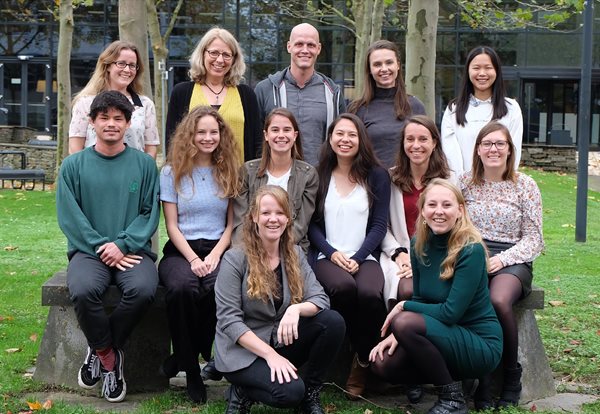
Skin-to-skin contact for an hour a day five weeks long between a mother and her full-term newborn baby changes the baby's gut microbiome. This is shown in research by Henrik Eckermann of Radboudumc, published in Gut Microbes.
The early colonization of the gut by microbes is a vital process because the microbiome not only helps digesting food. It also enables the absorption of nutrients, contributes to a proper functioning of the intestines, and plays an important role in fine-tuning the immune system. In recent decades, it became clear that the microbiome also interferes with reciprocal communication between the gut and the brain.
Colonizing the gut
In the baby's early life, the microbiome changes its composition due to breastfeeding, intensive contact with the mother and subsequently other family members, pets, antibiotic treatment and other factors. It is a good goal for babies to start with a healthy microbiome early in life. The question is: what does such a microbiome look like and in what way can it positively be influenced.
Skin-to-skin contact
In the SKIPPY project, researchers from Radboudumc are analyzing various aspects associated with skin-to-skin contact (SSC) of mothers and their full-term babies. During the SSC intervention, babies were placed on the mother’s bare chest with only a diaper on. Mothers in the SSC group were instructed to conduct SSC for an hour a day for five weeks. This SSC group was compared to a group that provided care as usual. Among other things, the SKIPPY project found mothers in the SSC group were less anxious and tired, they breastfed for longer, and their babies slept more and cried less. All in comparison with the control group.

Influencing the gut microbiome
Within the SKIPPY project Henrik Eckermann investigated whether skin-to-skin contact of mother and child affected the development of the baby's gut microbiome by examining baby stool samples at 2, 5 and 52 weeks after birth. Eckermann: "We looked at various aspects such as which bacteria were present in the intestines, which metabolites they are likely to produce, how volatile the composition of bacteria was over time and how mature the microbiota was for the age of the infant. Babies in the SSC group showed less volatility, so fewer major changes in the composition of their microbiome. In addition, we saw the outgrowth to an adult microbiome took a little longer in them than in babies in the control group."
Transfer of bacteria
Research on skin-to-skin contact in preterm babies shows positive effects on brain, cardiovascular and physical development. In the still sporadic research on the effects in full-term babies, which is what we are concerned with here, no clear conclusions can yet be drawn, says Eckermann. "Is a less volatile development of gut bacteria positive or negative? Is this slower development into a 'mature' bacterial composition an advantage or disadvantage? Much about this remains to be figured out. So does the exact mechanism of action of this skin-to-skin contact. Does it reduce stress and does this affect bacterial composition? Does bacterial transmission through breastfeeding explain the observed effect? - yes to some extent regarding the findings on microbiota maturation, but not completely, and breastfeeding is unrelated to the effect on volatility. So, these are questions for future research. And how important is direct skin contact in transmitting bacteria to the baby’s gut? Our results suggested that transmission occurs similarly in both treatment and control group.”
The question remains how important direct skin contact is in transferring bacteria to the baby's gut. Although we see SSC has an effect on the microbiome, this effect is not explained by an increased transfer of skin bacteria. Maybe it proceeds through a stress reducing effect for baby and/or mother."
Gut-brain axis
Eckermann shows that daily skin-to-skin contact changes the development of the microbiome in healthy full-term infants, but how to interpret these changes - healthy or not? - remains unanswered for now. Eckermann gives a nice example of the complexity of his research: "At present, we know over forty metabolic pathways involved in communication between the gut and the brain. The breakdown of serotonin and production of histamine are a few examples. We estimated the produced metabolites and found that the SSC babies may break down less nitric oxide and make more butyrate and acetate, compared to the control group. Bacteria such as Faecalibacterium, Roseburia, Eubacterium, Anaerobutyricum Anaerostipes, Coprococcus and Subdoligranulum can all make butyrate and this is just one of the many metabolic pathways. The different variables that all reflect some aspect of the gut microbial ecosystem reflect the complexity of microbiome studies."
-
Paper in Gut Microbes: Daily skin-to-skin contact alters microbiota development in healthy full-term infants - Henrik Andreas Eckermann, Jennifer Meijer, Kelly Cooijmans, Leo Lahti & Carolina de Weerth
-
Want to know more about these subjects? Click on the buttons below for more news.





